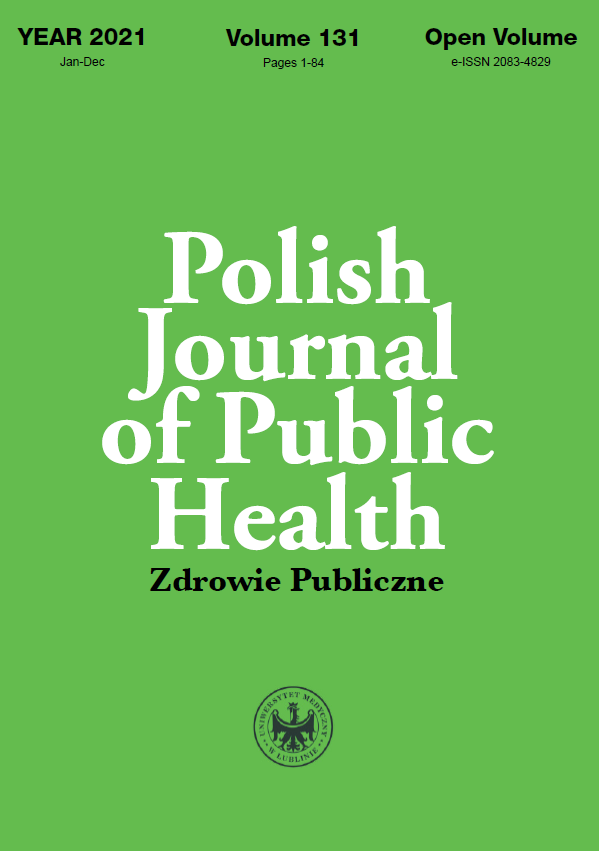Assessment of the risk of postpartum depression and the support expected and received by women within a year of giving birth
DOI:
https://doi.org/10.2478/pjph-2021-0012Keywords:
postpartum depression, Edinburgh Postnatal Depression Scale, social supportAbstract
Introduction. Postpartum depression (post-natal depression, pure postpartum depression, PPD) is one of three types of post natal mood disorders. The degree (severity) of this disorder may be defined as moderate or severe. A milder form of depression is postpartum sadness (baby blues), while the untreated depression can develop into a very severe form of depression called postpartum psychosis.
Aim. The aim of the work was to analyse the incidence and severity of postpartum depression symptoms in women in the first year after giving birth, evaluated by the Edinburgh Postnatal Depression Scale, and the social support received and expected by them.
Material and methods. This paper presents the severity of depressive symptoms in 150 women measured by the Edinburgh Postnatal Depression Scale in the first year after their giving birth as well as the support received by them and the demand for it. Results. More than half of the women filling in the Edinburgh Postnatal Depression Scale achieved a result indicating a high risk of postpartum depression (more than 12 points). The severity of postpartum depression symptoms depended on the place of residence of women, was related to attendance antenatal classes, breastfeeding and the support received.
Conclusions. It would be advisable to initially assess the risk of postpartum depression in women immediately after childbirth and the social support available to them.
References
1. Pużyński S, Wciórka J. Klasyfikacja zaburzeń psychicznych i zaburzeń zachowania w ICD-10. Kraków–Warszawa: Uniwersyteckie Wydawnictwo Medyczne Vesalius; 2000.
2. Nylen K, Moran T, Franklin C, O’Hara M. Maternal depression: A review of relevant treatment approaches for mothers and infants. Inf Ment Health J. 2006;27:327-43.
3. Kosińska-Kaczyńska K, Horosz E, Wielgoś M, Szymusik I. Zaburzenia afektywne u położnic w pierwszym tygodniu po porodzie – analiza rozpowszechnienia i czynników ryzyka. Ginekol Pol. 2008;79(3):182-5.
4. Kossakowska K. Kwestionariusz rozpoznawania objawów depresji poporodowej – polska adaptacja i psychometryczna ocena kwestionariusza Postpartum Depression Screening Scale (PDSS). Postępy Psychiatr Neurol. 2012;21(2):123-9.
5. Kossakowska-Petrycka K, Walęcka-Matyja K. Psychologiczne uwarunkowania wystąpienia depresji poporodowej u kobiet w ciąży o przebiegu prawidłowym i ciąży wysokiego ryzyka. Ginekol Pol. 2007;78(7):544-8.
6. Chrzan-Dętkoś M, Dyduch-Maroszek A. Humięcka A, et al. Uwarunkowania i konsekwencje depresji poporodowej. Psychoterapia. 2012; 2(161):55-63
7. Borysiewicz K. Edynburska Skala Depresji poporodowej. Postępy Psychiatr Neurol. 2000;(9):71-7.
8. Maliszewska K, Świątkowska-Freund M, Bidzan M, et al. Ryzyko depresji poporodowej a cechy osobowości i wsparcie społeczne. Polskie przesiewowe badanie obserwacyjne matek 4 tygodnie i 3 miesiące po porodzie. Psychiatr Pol. 2017;51(5):889-98.
9. Maliszewska K, Bidzan M, Świątkowska-Freund M, et al. Personality type, social support and other correlates of risk for affective disorders in early puerperium. Ginekol Pol. 2016;87(12):814-9.
10. Dennis C-L, McQueen K. The relationship between infant-feeding outcomes and postpartum depression: a qualitative systematic review. Pediatrics. 2009;123(4):736-51.
Downloads
Published
Issue
Section
License
Copyright (c) 2021 Authors

This work is licensed under a Creative Commons Attribution-NonCommercial-NoDerivatives 3.0 Unported License.


